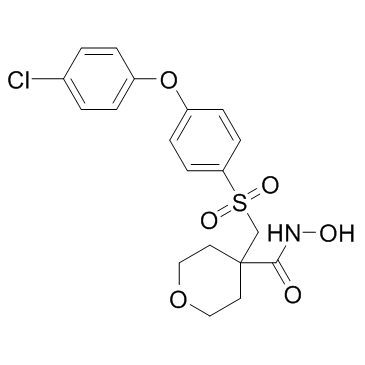| Description |
CTS-1027 is a potent small molecule inhibitor of MMPs, with IC50s of 0.3 nM, 0.5 nM for MMP2, MMP13, respectively, and has > 1,000 fold selectivity over MMP1.
|
| Related Catalog |
|
| Target |
IC50: 0.2 nM (MMP2), 0.5 nM (MMP13), 0.7 nM (MMP12), 0.9 nM (MMP8), 9.5 nM (MMP3), 15 nM (MMP14)
|
| In Vivo |
CTS-1027 significantly reduces the hepatocyte apoptosis, features of cholestatic liver injury, amd markers of hepatic fibrogenesis in the BDL mouse. CTS-1027 improves overall animal survival following 14 days of BDL in mice[1]. In male animals treated for 8 weeks the terminal plasma concentration of RS-130830 is 311±45 nM. Treatment of male mice with RS-130830 for 8 weeks causes an 89% increase in plasma triglyceride concentration, but there is no corresponding effect in female mice treated for 12 weeks. The plaque lipid content of animals receiving RS-130830 is increased by 81% at 12 weeks, and increased by 41% at 16 weeks[2].
|
| Animal Admin |
For experimental procedures, mice are anesthetized with ketamine 60 mg/kg plus xylazine 10 mg/kg body weight by intraperitoneal injection. After a midline upper-abdominal incision, the peritoneal cavity is opened, the abdominal wall retracted, and the common hepatic bile duct is double-ligated below the bifurcation and transected between the ligatures as previously described by us in detail. Sham-operated mice, used as controls, also underwent similar laparotomy with exposure but without ligation of the common bile duct. The fascia and skin of the midline abdominal incision are closed with sterile surgical 5-0 sutures. Either CTS-1027 or the vector carboxymethylcellulose are administered by gavage in a dose of 10 mg/kg body weight once a day. Drugs are prepared freshly on the day of the study. After 14 days of BDL and gavage, mice are re-anesthetized, sacrificed and blood is obtained from the inferior vena cava for serum total bilirubin and ALT determinations and the liver is removed, cut into small pieces and either snap-frozen in liquid nitrogen for storage at −80°C or fixed in freshly prepared 4% paraformaldehyde in phosphate-buffered saline (PBS) for 48 hours at 4°C for additional studies. Liver tissue is also subjected to RNA extraction using the Trizol reagent. Serum bilirubin and ALT determinations are performed as previously described.
|
| References |
[1]. Kahraman A, et al. Matrix metalloproteinase inhibitor, CTS-1027, attenuates liver injury and fibrosis in the bile duct-ligated mouse. Hepatol Res. 2009 Aug;39(8):805-813. [2]. Johnson JL, et al. Effect of broad-spectrum matrix metalloproteinase inhibition on atherosclerotic plaque stability. Cardiovasc Res. 2006 Aug 1;71(3):586-595.
|
